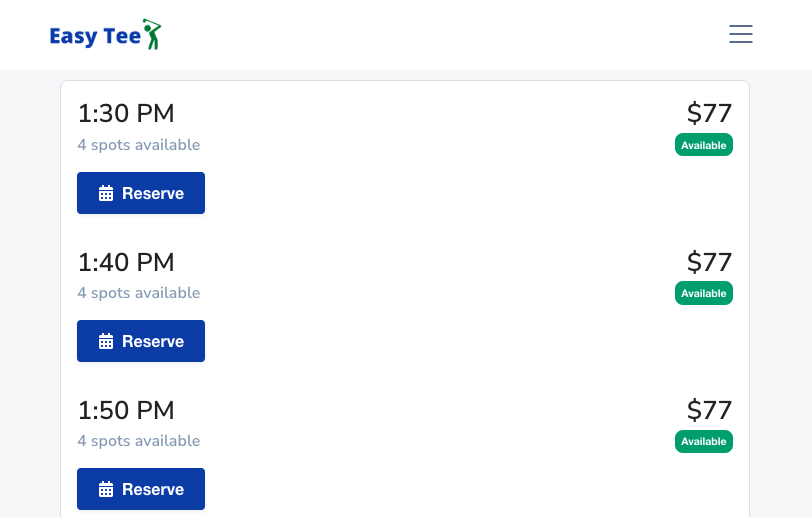How Golf Courses Can Optimize Tee Sheet Intervals
Improve revenue and customer satisfaction with the right tee sheet intervals!

Ever wonder what makes a great round of golf? It’s more than just a great swing; it’s also about a smooth, enjoyable pace of play. For golf course managers, finding the sweet spot between maximizing revenue and ensuring customer satisfaction can be a tricky balancing act. A study, “Golf course revenue management: A study of tee time intervals” by Sheryl E. Kimes (Cornell) and Lee W. Schruben (U.C. Berkeley), provides some eye-opening insights into how a simple change—the tee time interval—can make a world of difference.
The study explores the concept of revenue management (RM) in the golf industry, a practice that’s long been successful for hotels and airlines but is often underutilized in golf. The goal of RM is to allocate the right capacity to the right customer at the right time and place. For golf courses, this means optimizing their “tee sheet” to maximize revenue per available tee time (RevPATT). This research focuses specifically on duration management by examining the impact of changing the tee time interval.
The Counterintuitive Finding: Shorter Intervals Aren’t Always Better
Intuitively, you might think that squeezing in more groups by shortening the time between tee times would increase revenue. The study, however, reveals that this can be a major mistake. The research used a dynamic simulation model to study how different tee time intervals affect course capacity and revenue. The model was built using real-world data from a time study of 90 players and simulated 100 days of operation for various intervals, from 7 to 14 minutes.
The key takeaway is that when the tee time interval is too short, the variability in players’ pace of play can create major bottlenecks, leading to a system that becomes unstable. For the course in the study, the theoretical bottleneck was found at hole 8, which had an average party play time of over 16 minutes. This meant that any tee time interval shorter than about 8 minutes was likely to cause severe backups on the course.
The study’s results were clear:
-
Wait times exploded at intervals of 9 minutes or less.
-
The maximum clubhouse queue (parties waiting to start) skyrocketed from just 1-2 parties at 12-minute intervals to over 30 parties at a 7-minute interval.
-
The realized capacity—the number of parties actually served in a 10-hour period—plateaued at around 51 parties for all tee time intervals of 11 minutes or less.
This means that while a course could theoretically schedule over 80 parties with a 7-minute interval, only 51 would actually get to start before the course’s 10-hour operating window closed.
How to Implement These Insights on Your Course
So, what’s the right move for your golf course? The study provides a clear roadmap for using a similar simulation-based approach to find your course’s optimal tee time interval.
-
Understand Your Course’s Capacity: Before you can implement any RM strategy, you need to understand your course’s true capacity. Don’t rely on theoretical calculations alone; consider the variability in pace of play and demand. The practical capacity of a course is often considerably lower than its theoretical capacity.
-
Conduct a Time Study: To get accurate data for a simulation, perform a time study to measure the average and standard deviation of play times on each hole. This will help you identify potential bottleneck holes, like hole 8 in the study, and determine how short an interval you can realistically handle.
-
Find the Optimal Interval: The goal is to find the tee time interval that maximizes revenue without sacrificing customer satisfaction. In the study’s case, a 10-minute interval and an 11-minute interval both served about the same number of parties and thus generated similar revenue. However, the 11-minute interval resulted in a “significantly shorter” wait time, leading to higher customer satisfaction. This is the sweet spot your course should aim for.
-
Embrace Simulation: The research demonstrates the power of a dynamic simulation model. This isn’t just a one-time fix. Future research using similar models can explore the impact of other factors like changes in management policies (e.g., mandatory cart use) or course design to further optimize your operations and revenue.
By carefully defining and managing capacity, golf courses can move beyond simple, fixed pricing and duration models. They can use strategic levers like tee time intervals to increase throughput and revenue while ensuring that every customer has a great day on the course.
If you’re looking for a tee sheet provider who can help you optimize your tee sheets we’d love to hear from you. Learn more about Easy Tee Golf.
If you’re interested in reading the full study referenced in this article, check it out here.
If you’re intered in our research on optimizing tee sheets at 9-hole golf courses, learn about it here.
Categories
teesheet optimization bookings intervals